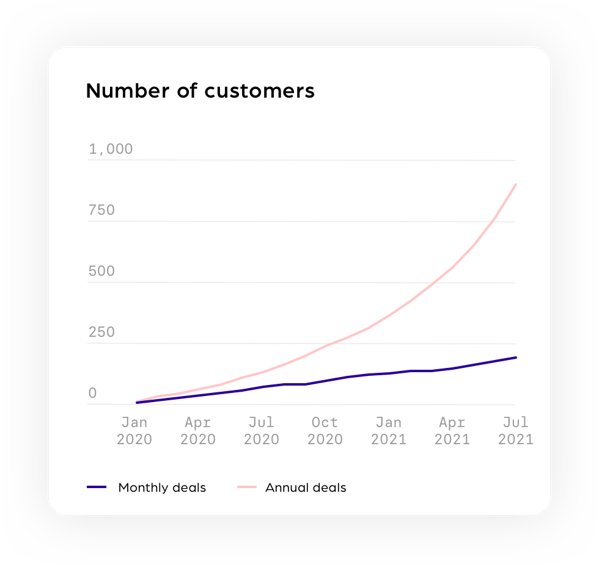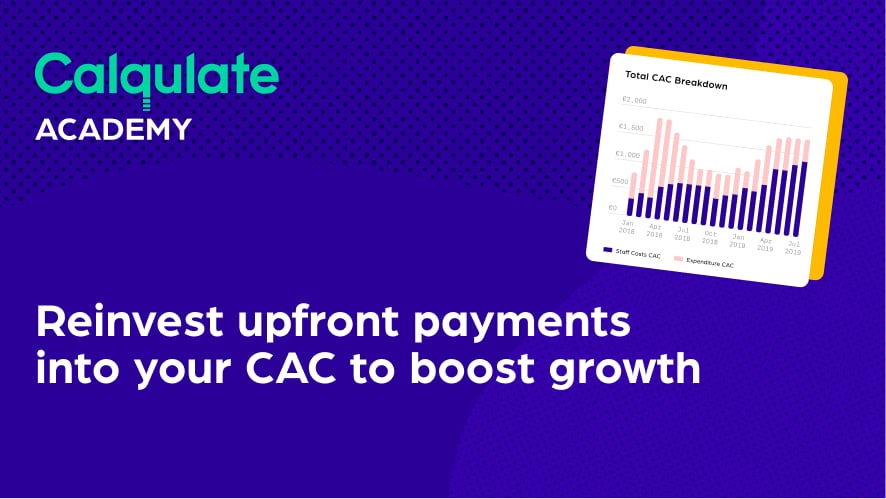It means that you’ll have excess cash available for reinvesting in growth from the beginning of the customer relationship. Having immediate extra cash will allow you to focus on onboarding new customers at a faster rate.
For example, instead of acquiring 180 new customers in 36 months on a monthly deal, you’ll have resources to acquire 863 new customers for the same period. That is almost 4x the amount!
You may wonder, how is that even possible?
Let’s take a look!
In the previous lesson, we looked at how annual subscriptions affect your revenue and cashflow forecasting. We’ve used the following scenarios as an example:
|
Scenario 1 |
Scenario 2 |
|
|
Customer Acquisition Costs (CAC) |
$900 per new customer |
$900 per new customer |
|
Monthly Recurring Revenue (MRR) |
$100 |
$100 |
|
Period |
36 months |
36 months |
|
Payment |
Monthly |
Annually |
The outcome:
@2x.png?width=601&name=Cumulative%20cashflows%20(5%20customers%20per%20month)@2x.png)
- With monthly deals, your CAC payback time is 17 months. Your cumulative ending cash balance after 36 months is $171,000, and lowest negative cash balance is -$18,000 on month 18 and 19.
- With annual deals, your cashflows are positive from Day 1. Your cumulative ending cash balance after 36 months is $270,000.
By now, we know that having annual deals is probably the best way towards that hockey stick growth effect. But how do you acquire more new customers in the same period without running your cash balance into the ground?
Reinvest upfront payments into your customer acquisition
In this lesson, we’ll continue to build on the above example.
Most startups would have raised at least seed funding and have monthly fixed expenses besides their customer acquisition costs. To make the comparison more realistic, we’ll add a starting cash balance and monthly fixed expenses into the mix.
Say, you have a starting cash balance of $1,000,000 and monthly fixed expenses of $20,000. We’ll keep the variables from Scenario 1 and Scenario 2. Your input values are:
Starting capital: $1,000,000
Monthly fixed expenses: $20,000
CAC per new customer: $900
MRR: $100
Period: 36 months
Payment: Monthly or annually
The monthly deals in Scenario 1 yields 180 customers in 36 months.
But we know that your cashflows are positive from Day 1 with annual deals in Scenario 2. When you reinvest your extra cash into further customer acquisition, you can onboard new customers much faster than 5 new customers per month.
Using the above variable, you increase your customer acquisition to 55 new customers in month 36. That translates to 863 customers in 36 months–almost 4x compared to monthly deals! How is this possible if every single new customer costs $900 to acquire?
The answer is: Annual upfront payments.

Let’s look at both scenarios from a cashflow point of view. Assuming you start with a $1,000,000 cash balance and pay $20,000 of fixed expenses every month.
- Scenario 1: By having monthly deals, you become cashflow positive only on the 4th year. After 36 months, you have 451,000 USD in the bank. You’ve already spent more than half of your money!
- Scenario 2: By having annual deals, you become cashflow positive on the 24th month. After 36 months, your cash balance is 1,050,000 USD, and the curve is positively upward. You would also have 4x more customers and more than 2x the money in the bank. Sounds pretty amazing!
@2x.png?width=624&name=Ending%20cash%20balance%20(monthly%20vs%20annual)@2x.png)
But that’s not all. Your annual deals will also affect your MRR.
MRR growth is the lifeline of any SaaS company. It’s an essential part of your company’s valuation and access to funding. The whole idea of having annual upfront payments is to fuel your MRR growth (because your growth rate matters!).
Here’s what happens in these two scenarios:
- Scenario 1: By having monthly deals, your MRR is $18,000 after 36 months. It is growing surely, but slowly. It’s not bad. But this will not land you a big Series A funding, or even cover your fixed expenses.
- Scenario 2: By having annual deals, your MRR will be $86,000 and snowballing. In the below chart, you can see that you’ll hit the magic $100,000 MRR goal in a few months. Now you’re really on to something. That upward curve is what your investors will look for. Great job!
@2x.png?width=602&name=MRR%20evolution%20(monthly%20vs%20annual)@2x.png)
Key takeaway:
It is possible to quadruple your MRR without raising money after your seed round. The secret is to gain access to extra cash that you can reinvest into your customer acquisition. It’s not a shortcut. Rather, it’s the fuel you need to grow your business. It’s all about growth, growth, growth!
Happy Calqulating!

